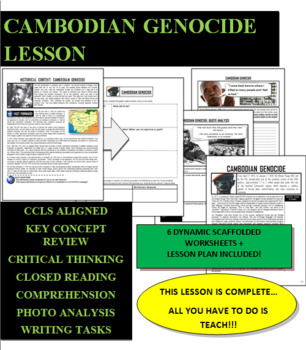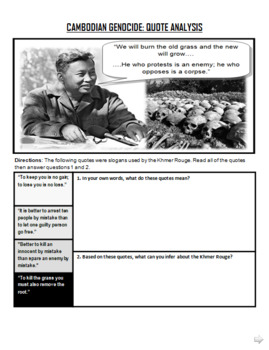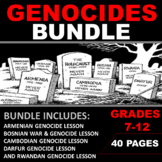Cambodian Genocide Lesson
The History Source
240 Followers
Grade Levels
9th - 12th, Homeschool
Resource Type
Standards
CCSSW.11-12.2
CCSSCCRA.R.4
CCSSCCRA.L.5
CCSSRH.11-12.7
CCSSWHST.9-10.2a
Formats Included
- Zip
Pages
7 plus Lesson Plan
The History Source
240 Followers
What educators are saying
This was a great resource to get my students involved in their next novel, which takes place in Cambodia.
Also included in
- This bundle includes five lessons that teach students about the Bosnian, Armenian, Darfur, Cambodian and Rwandan Genocides. Each lesson includes informational texts, comprehension questions and critical thinking activities.Perfect for in class or distance learning! [1] Armenian Genocide Lesson: ThisPrice $21.60Original Price $24.00Save $2.40
Description
This is a CCLS aligned lesson that teaches students about Pol Pot, the Khmer Rouge and the Cambodian Genocide. This lesson includes informational texts, guided reading questions, quote analysis, multiple-choice assessment questions, critical thinking writing tasks and graphic organizers. I have also included a written lesson plan for your convenience.
Perfect for in class or remote (distance) learning classes!
This Lesson is Complete... All You Have to Do is Teach!!!
Total Pages
7 plus Lesson Plan
Answer Key
N/A
Teaching Duration
N/A
Report this resource to TPT
Reported resources will be reviewed by our team. Report this resource to let us know if this resource violates TPT’s content guidelines.
Standards
to see state-specific standards (only available in the US).
CCSSW.11-12.2
Write informative/explanatory texts to examine and convey complex ideas, concepts, and information clearly and accurately through the effective selection, organization, and analysis of content.
CCSSCCRA.R.4
Interpret words and phrases as they are used in a text, including determining technical, connotative, and figurative meanings, and analyze how specific word choices shape meaning or tone.
CCSSCCRA.L.5
Demonstrate understanding of figurative language, word relationships, and nuances in word meanings.
CCSSRH.11-12.7
Integrate and evaluate multiple sources of information presented in diverse formats and media (e.g., visually, quantitatively, as well as in words) in order to address a question or solve a problem.
CCSSWHST.9-10.2a
Introduce a topic and organize ideas, concepts, and information to make important connections and distinctions; include formatting (e.g., headings), graphics (e.g., figures, tables), and multimedia when useful to aiding comprehension.






